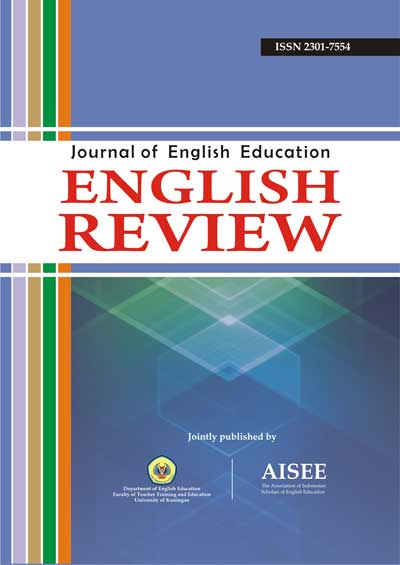ASSISTING STUDENTS TO ATTACK WRITING TASKS ON IELTS TEST WITH “PROBING TECHNIQUEâ€
Abstract
Abstract:  Writing section on IELTS test is commonly considered one of the most difficult parts of test. The test takers can’t even understand what to do with the tasks provided. They eventually write without clearly knowing the expected direction. Therefore, there should be a fastest way to well equip students to successfully cope with such hindrances. This paper is an action research report of how to make students better understand and answer writing tasks on IELTS test by employing probing techniques as one of test taking strategies. The paper will preliminarily elaborate the characteristics or nature of IELTS test in general and writing section consisting two different tasks in particular including its indicators of what expected kind of writing the testees should be aware of. It will then discuss probing techniques in details. The attack strategies and their sequential implementation will afterward be discussed. The technique will assist students to respectively understand what and how to plan and write effectively on the test.
Keywords: IELTS test, writing section, writing tasks, probing, attack strategies
References
Brown, H.D. (1994a). Principles of language learning and teaching. 3rd Ed. Englewood Cliffs, N.J.: Prentice Hall.
---------------. (1994b). Teaching by principle: An interactive approach to language pedagogy. Englewood Cliffs, N.J.: Prentice Hall.
Bruner, J. S. (1960). The process of education. Cambridge, Mass.: Harvard University Press.
Holton, Derek, and Clark, David. (2006). Scaffolding and metacognition. International Journal of Mathematical Education in Science and Technology, 37, 127-143.
http://changingminds.org/techniques/questioning/questioning.htm
Jakeman, Vanessa and Clara McDowel. (2007). Insight into IELTS. Cambridge University Press, Cambridge, UK
Kemmis, S., & McTaggert, M. (1988). The action research planner.(3rd edition). Victoria: Deakin University. http://www.stanys.org/RT/Action%20Research%20Spiral.pdf.
Oxford, R. L. (1990). Language learning strategies: What every teacher should know. Boston: Heinle & Heinle.
Robert J. M. and Kendall, J. (2007). The new taxonomy of educational objectives (second edition). Corwin Press. Sage Publication Company.
Slater, S. (2007). IELTS on Tract. South Wales: Center for Learning in University of New South Wales.
Williams, M. & Burden, R. (1997). Psychology for language teachers: A social constructivist approach. Cambridge: Cambridge University Press.
Willis, J. (1996). A framework for task-based learning. Essex: Longman.
Wijaya, M. (1999). Pendidikan teknik probing dan pembelajaran benda tegar. Unpublished Thesis. Bandung: UPI.
Wu, B. 1998. Towards an understanding of the dynamic process of L2 classroom Interaction. System 26, 525-540.
All articles published in English Review: Journal of English Education (ERJEE) are licensed under the Creative Commons Attribution 4.0 International License (CC BY 4.0).
Copyright Ownership
Authors retain the copyright of their articles and grant ERJEE the right of first publication. The journal is granted a non-exclusive license to publish, reproduce, and distribute the article in any format, medium, or platform, provided that proper credit is given to the original authors.
License Terms – CC BY 4.0
Under the Creative Commons Attribution 4.0 International License, others are free to:
- Share — copy and redistribute the material in any medium or format
- Adapt — remix, transform, and build upon the material for any purpose, even commercially
As long as they:
- Provide appropriate credit to the original author(s) and source
- Provide a link to the license (https://creativecommons.org/licenses/by/4.0/)
- Indicate if any changes were made
There are no restrictions on the reuse, reproduction, or adaptation of published articles as long as attribution is properly given.
Author Warranties
By submitting a manuscript to ERJEE, authors confirm that:
- The work is original and does not infringe any existing copyright.
- The manuscript has not been previously published and is not under consideration elsewhere.
- All sources and references are appropriately acknowledged.
- Necessary permissions have been obtained for any copyrighted materials used.










